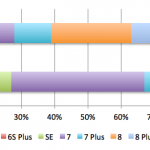iPhone X Delays Could Last As Long As Six Months, Analysts Say
Shortages of Apple’s new iPhone X could linger on for up to six months, analysts say, and this could create both benefits and risks for Apple.
The device won’t go on sale for another month and a half–November 3 to be exact, with preorders starting October 27. But with people waiting at the stroke of midnight on the 27 to preorder, existing supply will be depleted quickly, and delivery times will continue to be pushed back further for every hour after midnight that would-be buyers wait to place their order.
Part of the problem is that the iPhone X is densely packed with lots of custom components that aren’t easy to manufacture quickly. And Apple probably locked down the feature set of the iPhone X relatively late in the game, compounding the problem.
“It got right down to the wire,” says Patrick Moorhead, an analyst with Moor Insights & Strategy. “They were trying to put everything they could into the thing and still make it in time for the Thanksgiving and Christmas holidays.”
Moorhead said Apple faces some real risk by asking buyers to wait for weeks or months to get a new X, which sells for $999 for the 64GB version.
“There’s a possibility that people who want an OLED screen will see that Samsung can offer that same technology for less money, and it’s available today.” Moorhead said. He points out that Samsung’s Galaxy S8, S8 Plus, and Note 8 all have edge-to-edge OLED displays. Actually, it’s Samsung that supplies the OLED displays for the iPhone X.
Samsung’s mobile division naturally gets a good deal on the OLED displays from the company’s display division, which leads to lower prices. The 64GB version of the S8 is going for $694 at Best Buy, while the S8 Plus starts at $825.
Balancing Act
As Neil Cybart, an analyst at Above Avalon, points out, the simultaneous announcement of two new flagship iPhones (the 8 and 8 Plus) and an even more premium iPhone (the X) put Apple in the odd position of having to sound equally excited about both during Tuesday’s presentation. (The iPhone 8 starts at $699, the 8 Plus at $799, and the X at $999.)
“[Phil] Schiller had to initially talk up the iPhone 8 and 8 Plus as representing the best iPhones ever,” Cybart writes of the phones’ announcement in a brief today. “A few minutes later, Schiller was introducing the iPhone X and explaining why the iPhone’s future involved getting rid of the defining features found in the iPhone 8 and 8 Plus.” Those features, of course, are the LED display, TouchID, and the physical home button.
Apple no doubt wants a careful balance of sales between all three new devices. But how do you make sure the other, lesser phones sell as well as the X, which Apple calls “the smartphone of the future”?
The iPhone X shortage could be an important factor in this calculus. It might make the iPhone 8 or 8 Plus sound like a better option for one class of consumer, and it might increase demand for the iPhone X for another.
Mr. Right Now
For buyers who can’t decide between the iPhone X and the iPhone 8 or 8 Plus, the immediate availability of the 8 models might make all the difference.
“It gives all the people who were delaying upgrading their iPhone 6 and 6s the opportunity to upgrade to something not much more expensive and still be pretty cool, and not look like an antique, and not look like an Apple fan,” says Ronald Goodstein, a professor at Georgetown’s McDonough School of Business.
And Apple sweetened the iPhone 8 and 8 Plus deal by adding some compelling new features. The phones have glass on the front and back, they support wireless charging, and the Plus model has dual cameras with the new Portrait lighting modes.
Some people might decide those features, coupled with a much lower price, make the iPhone 8 a good option, Goodstein says.
On the other hand, he adds, the iPhone X delays could, for a certain class of buyer, make the phone seem even more desirable. Goodstein says it could make the iPhone X look like a scarce or rare thing that not everyone can get. And getting it before anybody else in the neighborhood might confer some status on the owner.
Either way, we won’t know how this balancing act is playing out until near the end of the year, Moor Insights & Strategy’s Moorhead said. At that point, some sales-by-model estimates might start coming out of the supply chain. In Apple’s earnings report in January, we may get some idea of the mix of sales by looking at the company’s overall profit margin. A higher margin number may suggest a higher proportion of iPhone X sales.
Fast Company , Read Full Story
(14)













